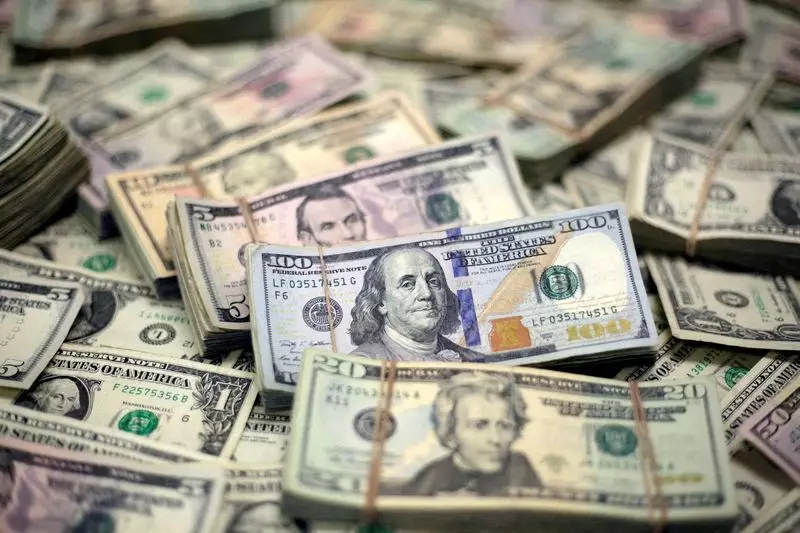Recently, the U.S. dollar has experienced a notable resurgence, reaching heights not witnessed in over two months. This strengthening can be largely attributed to expectations surrounding the Federal Reserve’s future monetary policy, particularly its inclination towards modest interest rate cuts. As the financial landscape continues to evolve, the interplay between economic indicators and currency values remains crucial for investors and policymakers alike.
The dollar index, which serves as a barometer for the U.S. currency against a basket of six major currencies, has climbed to approximately 103.18. This figure sits just below its peak of 103.36, achieved earlier this month. Such advancements highlight the currency’s resilience amidst a backdrop of fluctuating global markets and economic uncertainty. Moreover, analysts are pricing in the likelihood of a 25 basis point rate cut during the Fed’s upcoming meeting in November, reflecting a cautious but optimistic outlook among traders.
Recent economic data from the United States has contributed to the dollar’s ascent, with a paradoxical blend of resilience and modest slowing. Inflation figures for September slightly exceeded expectations, compelling traders to reevaluate the extent of potential rate cuts. The robust nature of the U.S. economy has led to a general consensus that immediate and drastic monetary easing is less likely, thus reinforcing the dollar’s standing in international markets.
Fed Governor Christopher Waller’s recent remarks have further influenced market sentiments. His emphasis on exercising caution concerning interest rate cuts signals that while gradual reductions may be anticipated, the pace will remain measured, taking current economic conditions into account. Waller’s warnings about potential disruptions in employment data due to recent natural disasters and strikes indicate that upcoming readings could portray a distorted view of the labor market, complicating decision-making processes for the Fed.
As the dollar gains strength, other currencies, particularly the Japanese yen, face mounting pressures. The yen recently traded at approximately 149.55 per dollar, reflecting the impact of a dovish shift in the Bank of Japan’s (BOJ) policies. Governor Kazuo Ueda’s cautious approach, combined with the new government’s stance against further rate hikes, has ignited uncertainty regarding future monetary tightening in Japan.
The yen’s fluctuation, which neared the critical 150-per-dollar mark, underscores the challenges faced by Japanese policymakers. The BOJ’s relatively relaxed stance contrasts sharply with developments in the U.S., creating a divergent monetary atmosphere that tends to undermine the yen’s value. Such currency dynamics are vital for businesses engaged in international trade, where fluctuations in currency valuation can significantly impact profit margins.
Across the Atlantic, the euro remains steadier in the face of uncertainty, trading close to its lowest level since early August. Market participants are closely watching the European Central Bank’s (ECB) upcoming policy meeting, where expectations lean toward further interest rate cuts. The euro’s position, while relatively stable, reflects an ongoing struggle within the eurozone as economic factors continue to evolve in response to various domestic and international pressures.
As the ECB navigates the precarious balance between stimulating economic growth and managing inflation, its decisions will undoubtedly influence the euro’s trajectory in the coming months. Any shifts in policy could result in significant ripple effects across global currency markets.
Meanwhile, China’s economic challenges are drawing attention as the nation contemplates additional stimulus measures. Reports of potential fiscal injections via treasury bonds to aid economic recovery could bolster the yuan. The offshore yuan’s resilience indicates a market poised for potential adjustments should these measures materialize during significant political gatherings, like the upcoming session of the National People’s Congress.
Market analysts are interpreting these developments as crucial for understanding global economic trends. As countries react to their internal economic pressures, the interconnectedness of currencies becomes more pronounced, highlighting the importance of monitoring these shifts for investment opportunities.
The ongoing dynamics of currency valuation reflect broader economic realities, with the U.S. dollar solidifying its position, the yen demonstrating vulnerability, and the euro bracing for pivotal decisions. Investors should remain vigilant in analyzing how these developments will influence market trends in the near future.

